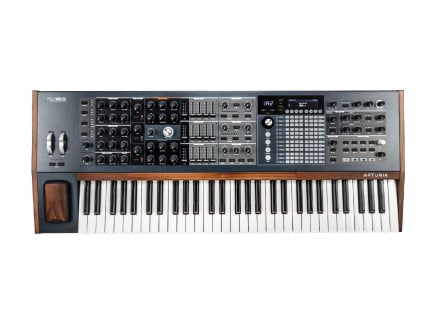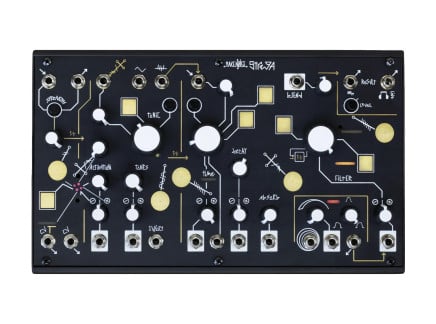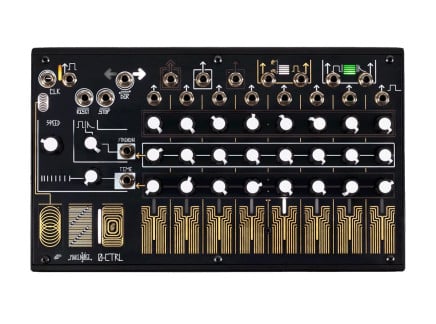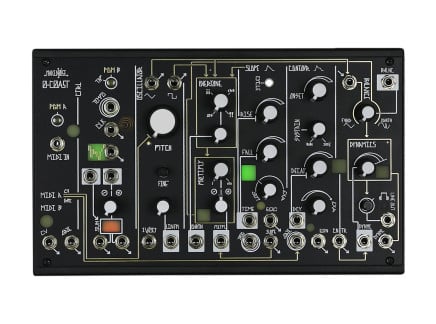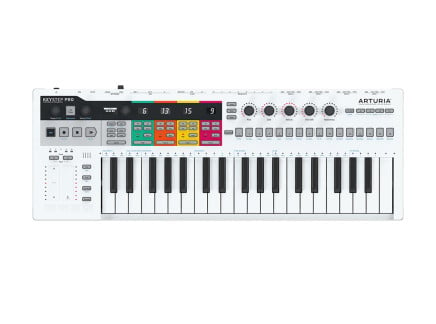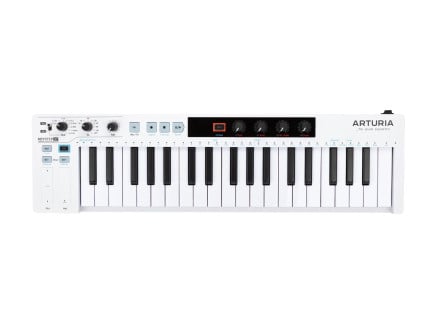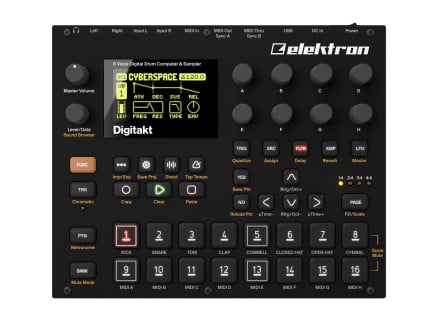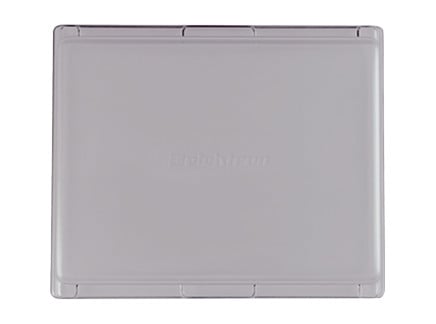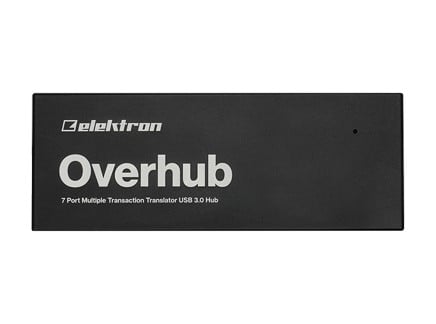As the year draws to a close, we've been taking a look back at some of our favorite gear from 2021. We recently published an article about the Signal staff's top picks for synths this year, discussing everything from the new Hydrasynth Explorer to Mutable's Beads and beyond...but we thought it'd be fun to take the conversation out of the office and into the real world. So, we got in touch with some of our friends and favorite artists/electronic musicians to see what they had to say.
Happily, they didn't entirely restrict themselves to gear that came out this year, instead taking a much more open-ended approach. Instead, they asked themselves the question: what's the best gear you can get in 2021? We wound up with high praise for brand new instruments, trusted standbys, and even gear that we were otherwise unfamiliar with. Thanks to Andrew Huang, Benn Jordan, Venus Theory, Sarah Belle Reid, Molten Music Technology, Ihor, and The Messy Desk for their contributions; and without further delay, let's dig in.
Benn Jordan's Pick: Arturia Polybrute
Given the nearly ecstatic nature of his own overview video (above), it shouldn't be surprising that Benn Jordan (the Flashbulb) chose Arturia's Polybrute as his top synth pick of 2021.
Arturia has steadily made a name for itself by making incredible products that are well thought-out and sound great. Their synths came onto the scene just ripping with their Brute line and the summit has been reached with the Polybrute. This absolute unit of a synth is a 6-voice analog polyphonic synth with a modulation matrix, solid effects, and a unique Morphing parameter that allows you to blend between two settings. Whatever your experience level is, there's something for you, be it room to grow or just a trove of options available to you. Above all else, it sounds amazing and is fun to play.
While it looks like a normal keyboard with a wood block on the side, that wood block is one key to the expressiveness of the Polybrute. Using three dimensions of control and modulation—X, Y on the wood and Z by applying pressure—the Morphee controller can design your perfect patch for tonal, textural, or rhythmic interaction. In conjunction with a sneaky wooden ribbon control strip right above the keyboard, the Polybrute is a fun machine to play. Particularly because there is a sequence recorder which can free you from playing the keys letting you use the ribbon with one hand and the Morphee in the other hand.
A deceptively simple oscillator section is the beating heart of the Polybrute: there are two analog oscillators which each have their own unique characteristics and can be blended in a way to create luscious pads, sharp FM leads, and nasty sync'd basslines. The first oscillator utilizes a Metalizer to mangle the waveform and the second features a Sub oscillator. Both oscillators have the same saw-to-triangle shapes with an added pulse/square wave that can be added and each has their own dedicated mix level control. In the mixer section, there's a third Noise level control that lets you bring in the noise oscillator. All three of these can be routed to one or both of the on-board filters: the Steiner or the Ladder. These can be run in series or parallel with the ability to morph between the two stages; the Stiener is a multi-mode-morphing filter while the Ladder is a classic lowpass. With the routing and quality of the voices, VCAs, and filters, it's really easy to finesse amazing sounds.

Finally, we need to touch on the modulation, because that is where the expandabilities become virtually endless. Across 3 LFOs, 3 envelopes, the aforementioned Morphee, aftertouch, and the ribbon controller, there is a lot to cover. Suffice to say: anything can modulate everything. Front and center is the Matrix, which can look daunting, but basically you find your modulation source on the left, tap one of the squares to the right and you're on your way to creating interesting, evolving patches. Like any instrument, it requires practice and patience, but it is fairly easy to get up and running with a full bevy of excellent presets. The Motion Recorder is another handy feature that allows you to record your knob and/or slider twiddling so each time you press a key, that same gesticulation happens. You can change the rate to happen faster or slower than you gestured. Combine that with the Arp/Sequencer and you have, essentially, a living organism.
A full featured, digital effects section is at the end of the chain with delay, reverb, and modulation effects each with their own parameters and flavors. Of course, these can also be added to the modulation matrix. An instrument this robust and full featured is hard to convey in words, let alone just a few paragraphs, so we suggest you try it in person for the full, ecstatic experience of the Polybrute. Just be sure to give yourself ample time to zone out.
Andrew Huang's Pick: Hologram Microcosm
It would only make sense that with as many musical interests that Andrew Huang has displayed over the years, his pick for 2021 would be something that could be useful with nearly any instrument imaginable. As it so happens, Microcosm might just be that thing. It has only been available directly from Hologram Electronics thus far, but it's certainly generated quite a buzz that has even renewed interest in their two previous products: Infinite Jets and Dream Sequence. Yet in a lot of ways, the Microcosm combines and enhances the best elements of its predecessors, while adding in some highly appreciated features like MIDI, stereo I/O, and extended expression control.
In short, Microcosm is a multi-mode pedal which offers a number of ways to manipulate sound, through techniques as simple as pattern delays and looping to full-on granular processing. In addition to the 11 different effect types, there's also a lowpass filter, stereo reverb, pitch modulation, and phrase looper which may be placed before or after the effects block. As the pedal's name suggests, Microcosm is perhaps a single encapsulation of audio processing and synthesis methods from a much broader world of influences. Everything from lush ambiences to up-front, sporadic glitches can be found in this pedal.
The 11 effect types are further broken down into four different groups: Micro Loop—short looping layers over your input signal, Glitch—bursts, interrupts, and otherwise unpredictable rearrangements of audio, Granules—granular processing to create textures, and atmosphere, and Multidelay—expansive multi-tap delays. These main effects all occur before the pitch modulation, reverb, and effects, so Microcosm offers plenty of ways to make warbly, washes of sound. On top of that, the Phrase Looper can be placed before or after all of the effects, making it possible to capture an idea and mangle it to your heart's content, or build up layers of highly affected sounds.
Whether you're a guitarist looking to texturize your playing, a synthesist seeking intergalactic ambiences, or a producer in need of a MIDI-controllable box of magic, Microcosm has something for everyone in search of a different kind of audio processor. We're excited to see more wonderful music being made with this one-of-a-kind effects unit.
Sarah Belle Reid's Pick: Make Noise Strega
Sarah Belle Reid is no stranger to Perfect Circuit; she's done a number of projects with us, including an excellent video about how to get started with modular synths, along with an accompanying article/interview about the process of learning about synthesis. We were happy to find that she was among the first to get their hands on a Strega; and truthfully, given its embrace of chaos, it's no surprise that it's her favorite instrument of the year.
Designed in collaboration between musician Alessandro Cortini and Make Noise's Tony Rolando, Strega is a self-contained semi-modular synth like no other. Deviating from traditional synthesis structures and instead encapsulating many of Cortini's own musical values in a single device, Strega presents a dark, murky sound world full of deep, buzzing drones and churning, bubbling noise. Perfect for dark, ambient soundscapes or experimental improvisation, Strega can go from tonal to chaotic at a moment's notice...and it remains deeply nostalgic and sentimental all the while.
Technically, Strega includes an oscillator, waveshaper, delay, filter, looping envelope, and chaotic CV generator, as well as a preamp/envelope follower for external signals. These individual submodules feature many dedicated patch points, as well as input/output routing via front-panel touch plates...allowing you to "circuit bend" or "patch" the synth purely with touch alone. To reduce Strega to a list of its components, though, would be unfair: it's a surprisingly organic instrument that can cause you to question what each of the individual submodules truly can do. The oscillator can be a source of random, aperiodic low-frequency clicks; the envelope can be a sound source; the delay can turn into a constant source of churning, undulating chirps and noise like the crunching of leaves; the list goes on. Strega also pairs splendidly with Make Noise's 0-Ctrl, creating a completely self-sufficient instrument for everything from twinkling sequences to unabashedly brutal noise.
Coming from the world of modular synthesis, where so many devices strive to be as general-purpose as possible, Strega is a breath of fresh air: an instrument with a highly-refined aesthetic angle that truly sounds and behaves like itself and nothing else. But despite its very clear style, it can still do so much at the hands of different musicians, and we're confident it's destined to become a classic instrument. (By the way, if you want to check out more of what Strega can do, check out Sarah Belle Reid's release MASS from March of this year, on which every single sound was either produced by or processed by Strega!)
Ihor's Pick: Noise Engineering Versio Series
This year, techno maestro Ihor chose to spotlight not just a single Eurorack module, but rather a clever series of stereo effects from one of our favorite instrument makers: Noise Engineering's Versio. While Ihor himself physically owns an Imitor Versio, he takes full advantage of the versatility that the Versio series has to offer as an effects platform with a number of different personalities, specifically gravitating towards the Ruina Versio stereo distortion and waveshaper.
Indeed, the coolest thing about the Versio line isn't just that whichever module you pick will instantly add a substantial dose of Noise Engineering's signature flavor of DSP effects to your rack. But the fact that you can easily pull out the module, flash a new firmware, and have a totally different effect to explore packs incredible value into what would otherwise be just a single module. Noise Engineering chose to build the Versio series on Electrosmith's Daisy, which is an open source, DSP programming platform. Doing this not only allows Noise Engineering to develop new ideas without sinking costs into additional hardware development, but libDaisy, the audio code framework upon which the modules are built, is available for anyone to explore and develop their own effects and synthesizers.
Desmodus Versio was the first one released, offering Noise Engineering-style destruction in the form of a wild, CV-friendly stereo reverb effect. It was always promised that other firmwares would follow, given the flexibility provided by the Daisy platform, and NE certainly delivered. Our Patch Pals Jacob and Wes took a look at the Versio series earlier this year when the crushing Ruina Versio was released, after the lovely multi-tap delay Imitor Versio had been unveiled a few months prior. Since then, NE has added even more firmwares since then, including Melotus and Ampla Versio, with more always on the way—whether they be from Noise Engineering themselves or the online community of users at large.
Of course, for those who want to have accurate faceplate labeling or multiple modules dedicated to specific firmwares, Noise Engineering offers a number of the various firmwares pre-installed on full modules, as well as replacement panels that are available a la carté from them directly. I don't think the value of adding a Versio to your collection can be overstated, it's just that versatile and easy to add a new flavor to your Eurorack system whenever you're craving a change.
Venus Theory's Pick: Arturia Keystep Pro
Keystep Pro didn't come along this year...but despite that, there's still nothing quite like it. That's why it was Venus Theory's top pick for gear you can get in 2021: it is a powerful multichannel controller capable of acting as the brain of virtually any electronic music production or performance setup.
More than just a MIDI controller, the Keystep Pro from Arturia is a compact powerhouse for composition. Centered around a 4-track sequencer, these independent tracks can be routed to any of the 16 MIDI channels or 4 CV outputs. The first track also has a Drum mode that makes use of the 8 Drum Gates. Aside from the sequencing options, the feel of the keyboard is wonderful with 37 slim keys that offer aftertouch and velocity sensitivity, so expressivity is easily achieved.
Each of the four sequencing tracks is independent and can be programmed to have up to 64 steps. Programming the Keystep is pretty straight forward with the option to manually program notes in, or you can record your notes in real time. When recording the notes, you can have the sequence be quantized to the tempo/divisions or not allowing for more organic patterns to emerge. The velocity, aftertouch, mod wheel, and CC knobs are also recorded. The patterns can be left at that, however, the performance controls bring sequencing to the next level. You can transpose all or some of the tracks, randomize the step order, randomize the step trigger probability, randomize the notes, dynamically shift pitches that are quantized to a scale, nudge the entire sequence, add individual swing per step—the list can go on.
Performance was well thought out when designing this interface and everything is easily accessible thanks to the many buttons and well placed indicator lights. The Keystep Pro is a fun instrument to play and with so many ports of expandability this can really be the center of your studio and performance workflow. The 4 Voice CV outs each have Pitch, Mod/Velocity, and Gate outputs and the addition of 8 individual Gate Outs for the Drum sequencing means you can power a full Eurorack with ease. The incredibly handy addition of two MIDI outs makes connecting multiple devices a breeze and syncing everything is simple, too, with dedicated clock outputs.
For versatility and musicality, the KeyStep Pro is hard to beat. Its compact size fits easily in any studio and its connectivity can power you as you expand your setup. Excellent software, customizability, and creative performance options: it's everything you could want in a controller.
The Messy Desk's Pick: Elektron Digitakt
Our beloved Dan from The Messy Desk not only made the wise move to purchase a Digitakt this year, but also highlights it as his favorite product of the year. Marketed as a drum machine, Elektron's Digitakt is a fantastic sampler and sequencer that goes above and beyond many of the drum machines found on the market to this day. The Digitakt can sample internally and externally, be used as an audio interface, and performs not only eight audio tracks, but also eight additional MIDI tracks! I could go heavily into detail on why this beast of a machine is such a workhorse, but I'll try to keep it short and sweet.
To start, the eight audio tracks have tons of flexibility over their timbre with sample editing, a filter and amplitude section, bitcrushing and overdrive, and two flexible LFOs that can be assigned to almost any parameter. These audio tracks not only play back the sound or sample loaded to the track, but can swap between up to 127 different designable sounds via the Sound Pool option, and that's per project! Incorporating your other synths and machines is simple with the eight MIDI tracks—capable of setting up MIDI channel, program bank and changes, velocity, pitch bend, and even eight specific CCs.
Equally if not more powerful, Elektron's brilliant sequencer pushes Digitakt to some amazing boundaries with probability, retriggering, automation, and more. Initially, each track on Digitakt follows a simple 16-step sequence a tempo, quantized to the beat—this is simply a canvas for you to create beautiful sequences with control over each track's step length (up to 64) & clock division/multiplication AND each step's microtiming & retrigger conditions. On top of all that flexibility you still have a variety of conditional and parameter locking that allow you to give individual steps conditions on when they're played and whether or not to follow the base parameters or a specific set of parameters.
What ties Digitakt all together is the stellar master bus, showcasing eight levels for mixing your tracks, delay and reverb send effects, and a master bus compressor. What's really special is the master bus compressor can be sidechained internally or externally, and as of recent firmware updates, you can use Digitakt to mix in external sources that can be processed through the master bus compressor. There's even more depth for each of the previously listed topics as well as performance features, audio routing, and integration with your computer. If you're on the fence of its ability to enhance your productions and performances, we feature and talk about the Elektron Digitakt in many of our videos (here's our most recent).
Molten Music Technology's Pick: Wavefonix 8-Step Sequencer
This year, Wavefonix introduced their 8-Step Sequencer, a very simple yet powerful voltage and gate sequencer with multiple CV outputs, performable steps, and an overall amazing layout. Robin Vincent from Molten Music Technology mentioned the 8-Step Sequencer as his module of the year, and we can totally understand why: unlike many sequencers today, the 8-Step Sequencer doesn't throw you into hidden menus for accessory quantized tunings, ratcheting, direction, etc. Instead, it takes a simple 8-step layout and offers flexible and performable steps for creating a wide range of CV/Gate uses to control anything you'd like.
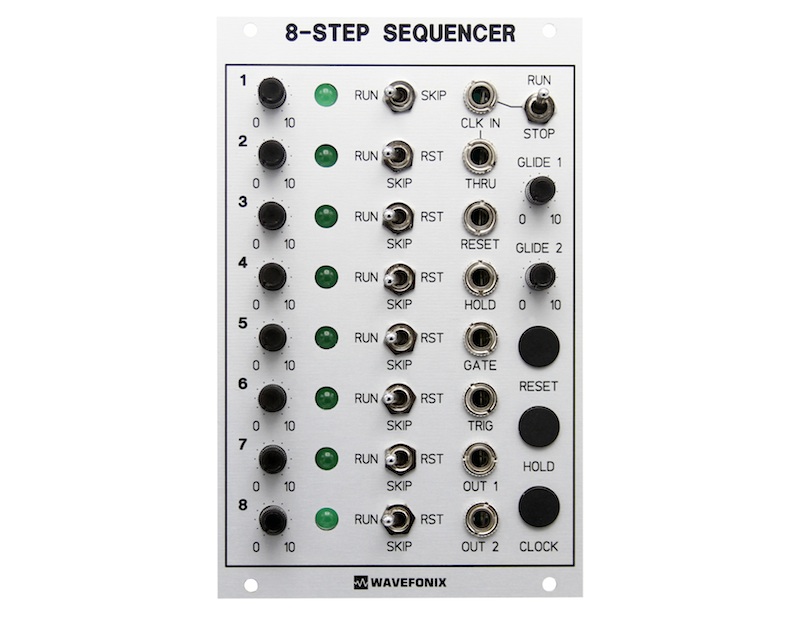
Whether you're starting to get into modular or are looking for an easy to use interface, the 8-Step Sequencer provides tons of room for realizing ideas. Each step offers control over pitch CV ranging from 0 to 10V (10 octaves), and this not only outputs one but two identical CV sequences with individual glide controls. Although these aren't quantized to a scale, that makes them all the more flexible to add very specific tunings for modulating pitch, filter frequency, LFO rate, and so much more. Each step also determines the play mode dictated by the RUN-SKIP-RST switches, in which you either play the step, skip the step, or reset to the first step after passing. These switches are quite performable for making malleable and poly-metric patterns, anywhere between one to eight steps long.
Running off an external clock, you have a RUN/STOP switch for bringing in and out the sequence, and with a THRU CV out, you can keep your clock going throughout your modular case without the need of a multiple module. If you'd rather not use a clock source, you can manually step through your sequence via the CLOCK button. Holding and resetting the sequence are as easy as a press of a button, but you can also use CV to trigger them—since the inputs are comparator-based, you can use any type of CV (not just gates/triggers) to control these! The 8-Step Sequencer from Wavefonix offers dynamic and easy-to-use controls for molding intriguing and creative sequences.
Best =/= Newest
With a variety of gear like this, it's clear that 2021 is a heck of a time to make electronic music. From the spacey, glitched out Microcosm to gnarly, noisy Strega and powerful, flexible Polybrute, the variety of things you can have today is truly astounding. And despite the flashiness and excitement that always comes along with brand new gear, we're happy our friends offered a reminder that sometimes, the newest thing isn't necessarily the best thing. In fact, sometimes falling back on a familiar and trusted tool is just the thing you need to get your creative juices flowing.
Of course, we couldn't stop here. Keep your eyes peeled...we'll return next week with thoughts from even more of our friends!

